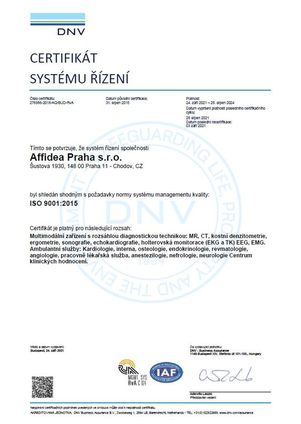

The rheumatology center deals with diagnostics and treatment of diseases of the musculoskeletal system. The clients who come to our center with joint difficulties for the first time go through a wide range of various diagnostic examinations. We provide clinical and ultrasonographic examination of the affected joints, synovial fluid analysis, capillaroscopy. There is also a possibility of CT or MRI examination as well as an X-ray and comprehensive laboratory testing.
We provide a long-term care to clients who suffer from rheumatoid arthritis, psoriatic arthritis, ankylosing spondylitis (Bekhterev's disease), reactive arthritis, polymialgia rheumatica, Sjögren's syndrome and other rarer inflammatory rheumatic diseases. We also take care of clients with early arthritis and undifferentiated forms of arthritis. We treat patients with gout and chronic gouty arthritis, with osteoarthritis of small hand joints or bearing joints of the lower limbs, painful limited mobility of the shoulder joint.
Joint ultrasound examination is non-invasive and painless. It allows the rheumatologist to display soft musculoskeletal tissues (tendons, ligaments, muscle ligaments, joint capsule and joint lining, synovial cysts and other structures). In many cases it is an indispensable part of rheumatological examination, e.g. for patients with the shoulder impingement syndrome or heel pain. The ultrasound examination is very sensitive regarding the signs of inflammation. This examination method is therefore very useful in the diagnostics of early forms of arthritis and in monitoring of the effectiveness of the treatment of the patients with a chronic inflammatory joint disease. The examination takes 15-30 minutes according to the number of examined musculoskeletal areas. No preparation is required before the examination.
Videocapillaroscopy of the nail bed skin is a non-invasive, painless and quick method to show morphologic changes in the microcirculation. It is necessary for all patients with Raynaud's phenomenon, ie disorder of blood circulation in the fingers. The result of the examination enables to distinguish between primary Raynaud's syndrome, ie functional disorder of blood circulation and between secondary Raynaud's phenomenon which accompanies systemic connective tissue diseases. The disorder of blood circulation in fingers along with pathological changes in capillaroscopic examination can precede diagnosis of a serious systemic disease by several years. Capillaroscopic examination therefore allows to identify patients who are at risk of developing these diseases. We use a modern videocapillaroscopic machine with a contact probe (x200 magnification) which allows to examine even patients with flexion contractures of the fingers or other deformities. Before the examination it is required not to cut, push back or otherwise treat the soft skin in the nail bed for at least 10-14 days and to carefully remove the nail polish. The examination takes approximately 20 minutes.
Ultrasound: Logiq S8 (produced by GEMS)
Capillaroscopy: VideoCap 3.0 machine (produced by DS Medica)
Before the examination it is necessary not to cut, push back or otherwise treat the soft skin in the nail bed for at least 10-14 days. Before the examination it is also necessary to carefully remove the nail polish (in case of gel nails they need to grow out at least 3mm).
Please come about 20 minutes before the examination so that you have 15 minutes to adjust in the warm waiting room.
Chief Physician
Physicians